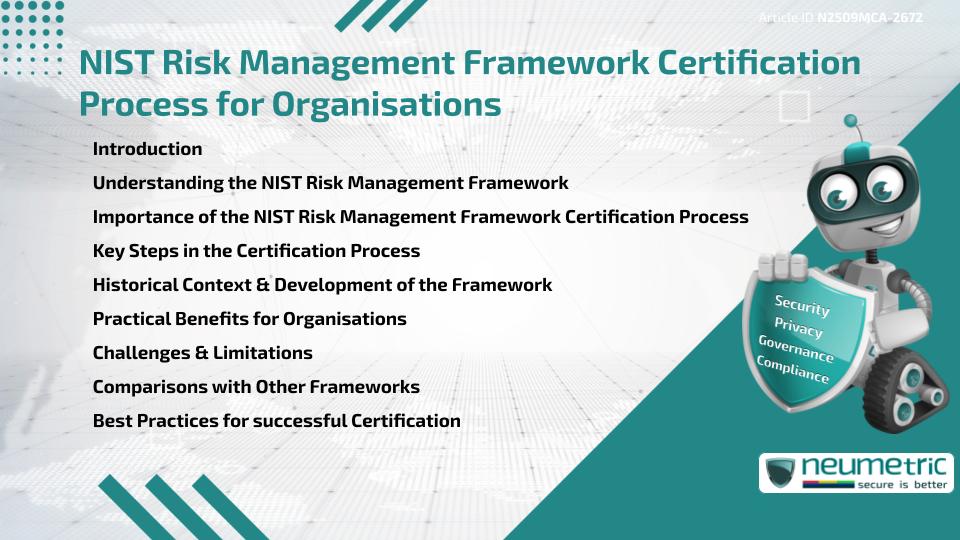Table of Contents
ToggleIntroduction
The NIST Risk Management Framework Certification Process provides a structured approach for Organisations to identify, assess & manage Risks within their Information Systems. This process is widely recognised for its emphasis on Continuous Monitoring, accountability & security Best Practices. Organisations use it to align their Operations with Regulatory requirements, strengthen Cybersecurity & build Trust with Stakeholders. This article explores the Framework’s origins, core components, Certification steps, benefits, limitations & comparisons with other frameworks.
Understanding the NIST Risk Management Framework
The National Institute of Standards & Technology [NIST] developed the Risk Management Framework [RMF] to integrate Security & Risk Management activities into the System Development Life Cycle. The Framework ensures Organisations follow a repeatable, scalable & Systematic approach to Risk. It covers essential steps like categorising Information Systems, selecting Security Controls, implementing Safeguards & continuously monitoring Compliance.
Importance of the NIST Risk Management Framework Certification Process
The NIST Risk Management Framework Certification Process is crucial for ensuring that Organisations meet Federal & Industry-specific requirements. It is often mandated for Government Agencies & Contractors but is increasingly adopted by Private Companies. Certification reassures Partners, Customers & Regulators that an Organisation prioritises Risk Management & has taken active measures to safeguard Data & Systems.
Key Steps in the Certification Process
The Certification Process involves several interconnected steps:
- Categorise the System: Identify the System & determine its impact level based on Confidentiality, Integrity & Availability.
- Select Controls: Choose appropriate Security Controls from the NIST catalogue.
- Implement Controls: Deploy & document the chosen Safeguards.
- Assess Controls: Conduct an independent Assessment to verify effectiveness.
- Authorise System: A Senior Official decides whether the Risk level is acceptable.
- Monitor Continuously: Maintain ongoing oversight to ensure Controls remain effective.
Each step contributes to a holistic understanding of Organisational Risk & strengthens Compliance with Federal Standards.
Historical Context & Development of the Framework
The NIST introduced the RMF in response to growing concerns about Cybersecurity & Data Protection. It built upon the Federal Information Security Management Act [FISMA] of 2002, which required Federal Agencies to protect Sensitive Information. Over time, the RMF expanded beyond Government use, providing guidance to Private & International Organisations seeking a standardised approach to Risk Management.
Practical Benefits for Organisations
Organisations that complete the NIST Risk Management Framework Certification Process gain multiple advantages:
- Improved Risk awareness & Control effectiveness
- Enhanced credibility with Regulators, Partners & Customers
- Better alignment with Federal Compliance Requirements
- Streamlined Audit Processes
- Stronger Cybersecurity Resilience
These benefits make the process not only a Compliance Tool but also a strategic enabler for long-term Operational success.
Challenges & Limitations
Despite its advantages, the Certification Process presents challenges. It can be Resource-intensive, requiring skilled Personnel, Time & Budget allocation. Smaller Organisations may find it difficult to keep up with ongoing Monitoring & Documentation requirements. Moreover, the Framework’s rigid structure may not suit Organisations seeking more flexible approaches to Risk Management.
Comparisons with Other Frameworks
The RMF is often compared to frameworks such as ISO 27001 & COBIT. While ISO 27001 focuses on establishing an Information Security Management System [ISMS] & COBIT emphasises Governance of Enterprise IT, the RMF integrates deeply with U.S. Federal requirements. Organisations may adopt multiple frameworks together, using the RMF as a foundation for Compliance & ISO 27001 for global alignment.
Best Practices for successful Certification
To successfully achieve Certification, Organisations should:
- Engage Stakeholders early in the process
- Invest in Staff training & Awareness
- Use Automation Tools for Monitoring & Documentation
- Perform regular Internal Audits
- Treat Certification as a Continuous Improvement initiative
Following these practices ensures the Certification Process is smoother, less costly & more effective.
Takeaways
- Provides a structured, reliable way to manage Cybersecurity Risks
- Resource-intensive but strengthens Resilience
- Builds Credibility & supports Compliance
- Understanding steps, challenges & benefits enables Best Practices
- Transforms Certification into a long-term Strategic Advantage
FAQ
What is the purpose of the NIST Risk Management Framework Certification Process?
The purpose is to help Organisations Systematically manage Risks, comply with Federal requirements & strengthen Security resilience.
Who needs to undergo the Certification Process?
Federal Agencies, Contractors & Organisations handling sensitive Government data must comply, but many Private Firms also adopt it voluntarily.
How long does the Certification Process take?
The timeline varies depending on System complexity, but it can range from several months to over a year.
What challenges do Organisations face during Certification?
Common challenges include Resource limitations, maintaining Documentation & sustaining Continuous Monitoring requirements.
Can Organisations combine the RMF with other frameworks?
Yes, Organisations often combine the RMF with ISO 27001 or COBIT to meet both Federal & International Standards.
Is the Certification Process mandatory for Private Companies?
No, but Private Companies in regulated Industries or those working with Federal agencies may need to comply.
How does the RMF improve Organisational Security?
It improves security by ensuring Systems are categorised, Controls are applied effectively & Risks are continuously monitored.
Need help for Security, Privacy, Governance & VAPT?
Neumetric provides organisations the necessary help to achieve their Cybersecurity, Compliance, Governance, Privacy, Certifications & Pentesting needs.
Organisations & Businesses, specifically those which provide SaaS & AI Solutions in the Fintech, BFSI & other regulated sectors, usually need a Cybersecurity Partner for meeting & maintaining the ongoing Security & Privacy needs & requirements of their Enterprise Clients & Privacy conscious Customers.
SOC 2, ISO 27001, ISO 42001, NIST, HIPAA, HECVAT, EU GDPR are some of the Frameworks that are served by Fusion – a SaaS, multimodular, multitenant, centralised, automated, Cybersecurity & Compliance Management System.
Neumetric also provides Expert Services for technical security which covers VAPT for Web Applications, APIs, iOS & Android Mobile Apps, Security Testing for AWS & other Cloud Environments & Cloud Infrastructure & other similar scopes.
Reach out to us by Email or filling out the Contact Form…


